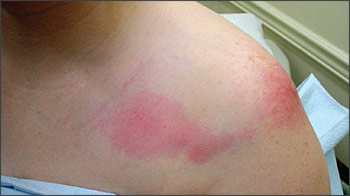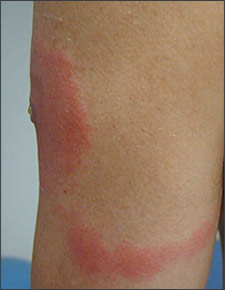
Am Fam Physician. 2006;74(1):145-147
A 31-year-old woman presented with a 12-hour history of pain, tenderness, swelling, and erythema over her left anterior chest wall nine days after receiving a primary smallpox vaccination. As instructed, she kept the site loosely covered with dry gauze and an adhesive dressing and made daily dressing changes. Two days before presentation, she experienced neck and supraclavicular pain on the left side that resolved within 24 hours. She had not missed work, although discomfort at the site during the previous 12 hours made it difficult for her to sleep.
At the time of her evaluation, she was afebrile and appeared to be well. She had no history of dermatologic conditions or immune compromise, was taking no medication, and had no known allergies to the vaccine components. The vaccination site (located high on her shoulder) appeared as a normal “robust” reaction appropriate for the postvaccination time course, with vesicle formation and some crusting. The area extending from the vaccination site was warm with a 2-cm × 2-cm area of painful induration near the center of the hyperemic area on the chest wall (Figure 1). There was no palpable or tender cervical or axillary lymphadenopathy.

Question
Discussion
The correct answer is C: provide symptomatic management. The range of expected reactions occurring after smallpox vaccination can include fatigue, headache, myalgia, regional (usually axillary) lymphadenopathy, lymphangitis, pruritus, vaccination site edema, and satellite lesions (see accompanying table1,2). These normal reactions usually do not require specific treatment.3 The incidence of “robust takes” (i.e., vaccination reactions larger than 10 cm in diameter) varies between 2 and 16 percent.1 Again, these reactions rarely require specific treatment.
| Normal reaction | Normal variants* | Adverse reactions† | |
|---|---|---|---|
| Day | Description | ||
| 0 | Vaccination | Local satellite lesions (normal in appearance) | Erythema multiforme |
| 3 to 4 | Papule | Lymphangitis | Bacterial infection |
| 5 to 6 | Vesicle with surrounding erythema vesicle with depressed center | Robust take (intense inflammation surrounding the papule) | Accidental implantation‡ |
| 8 to 9 | Well-formed pustule | Local edema | Vaccinia keratitis |
| 12+ | Pustule crusts over scab | Eczema vaccinatum | |
| 17 to 21 | Scab detaches, revealing scar | Generalized vaccinia, congenital vaccinia, progressive vaccinia, encephalitis | |
Lymphangitis near the vaccination site may occur with robust takes. This presents as erythema and induration surrounding the pustule and usually is most pronounced on days 8 through 10. A less common presentation shows a hyperemic and indurated band extending from the vaccination site (usually located over the middle or lower deltoid area) that traverses distally and then passes around the back of the upper arm toward the axilla and its regional lymph nodes (Figure 2).

This patient demonstrated a variation of the lymphangitis described above. The vaccination site usually is lower over the deltoid area than it was in this patient. In this case, the higher position of the vaccination site may have spared the patient axillary adenopathy (which often occurs with robust primary vaccine takes) and channeled the lymphatic drainage along a different route. This also may explain the patient’s neck and supraclavicular pain. The tender induration in the center of the erythematous area was likely an inflamed interpectoral lymph node.
This is a generally benign viral process for which antibiotics are not useful, antiviral agents and immune globulin are not indicated, and hospitalization is unnecessary. The transient lymphangitic infection and the local inflammation at the vaccination site are limited by the patient’s normal immune response. Because this type of reaction occurs almost exclusively with primary smallpox vaccinations, it is highly unlikely that it would recur with revaccination.